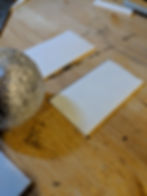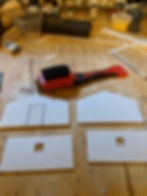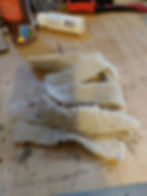How To Craft A Cheap Cottage For D&D
- Alan Valdmets-Harris
- Jan 7, 2019
- 3 min read
Dungeons & Dragons commonly takes place in pastoral farmlands and villages. Well, maybe not as commonly as in castles, caverns, forests, cities, pirate ships, literal hell, or giant-insect hives, but still pretty commonly. So clearly, you're going to want a cottage or two without breaking the bank.

I'm going to use three materials to construct this: Dollar Tree foam board, small wooden craft sticks, paint, glue, and an old towel. For tools I need a sharp craft knife, scissors, wire brush, a ball covered in aluminum foil, and a paint brush.

For this example I'm going to make a cottage with a removable base that measures 4" by 4". Because I want the walls to fit around the floor, the side walls will be exactly 4", but the front and back will be 4 1/2" long. The walls will be 2" high, with the roof rising an extra inch.

It's important to make the front/back walls longer so that the roof piece fits flush. If you attach the sides to the outside, you'll have a gap.
It's a good idea to do any cutting or texturing before gluing these pieces together so you can work on them lying flat. Some stucco texture can be added by rubbing the pieces with an aluminum foil ball.

I'm going to do a front door and two windows on the sides. I'm not cutting the door out; once it is opened I'm just going to remove the entire cottage piece and use the wooden flooring underneath, so there's no need to have a "working" door. I get a wood texture for the door by marking the boundaries and then carefully rubbing the area with a wire brush.

There are some options for the roof size, depending on how much overhang you want on each size. I'm trying 5"x3" so that there's a bit covering all sides.
With all these pieces ready, the house can be glued together. As you're probably aware, spray-painting foam can make it melt, so I do a quick base coat of an off-white/vanilla color for the walls, and get started on the door.

(Don't worry about that gap at the very top of the roof, it's going to be covered by thatching)
Some small craft sticks glued onto the joints not only looks realistic, but it also can cover up seams where the foam was glued together.

I use a little bit of watered-down brown paint to darken them up a bit while letting the natural woodgrain show through. This can also be watered down even more to do a bit of dark wash for the walls.
Our house is almost done! We just need some thatching for the roof. Get an old towel from a secondhand store that's a nice blonde straw color. Cut it into strips about an inch wide and 5 inches long.

Now I layer these strips on either side of the roof, with on strip running down the middle.

As mentioned previously, I use 1" plaster floor tiles, and this is built to fit around one of those. That way, when a character goes in to explore the cottage, I can just lift this piece off and it is easy to see everything going on inside.

Don't limit yourself only to cottages! There's no real limit to the size of your creations, and there's a million ways to modify this basic recipe. Happy crafting!
